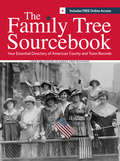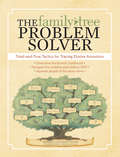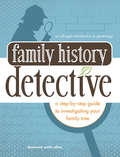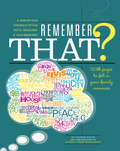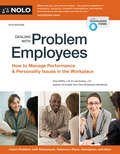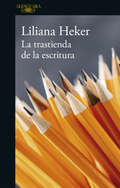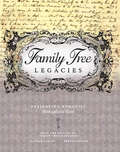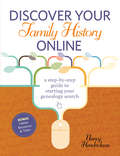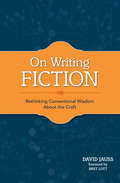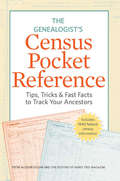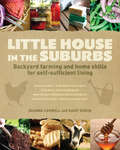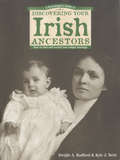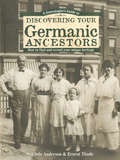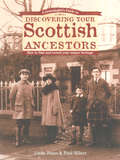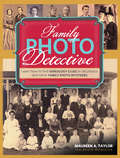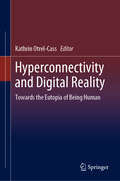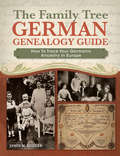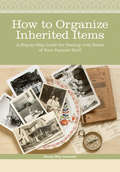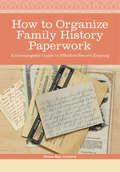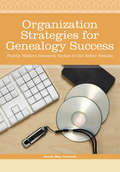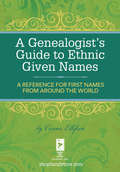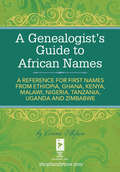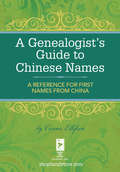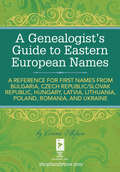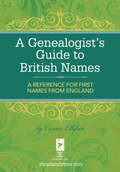- Table View
- List View
The Family Tree Sourcebook: The Essential Guide To American County and Town Sources
by Editors of Family Tree MagazineThe one book every genealogist must have! Whether you're just getting started in genealogy or you're a research veteran, The Family Tree Sourcebook provides you with the information you need to trace your roots across the United States, including: Research summaries, tips and techniques, with maps for every U.S. state Detailed county-level data, essential for unlocking the wealth of records hidden in the county courthouse Websites and contact information for libraries, archives, and genealogical and historical societies Bibliographies for each state to help you further your research You'll love having this trove of information to guide you to the family history treasures in state and county repositories. It's all at your fingertips in an easy-to-use format–and it's from the trusted experts at Family Tree Magazine!
The Family Tree Problem Solver: Tried-and-True Tactics for Tracing Elusive Ancestors
by Marsha Hoffman RisingProven Solutions for Your Research ChallengesHas your family history research hit a brick wall? Marsha Hoffman Rising's best-selling book The Family Tree Problem Solver has the solutions to help you find the answers you seek.Inside you'll find:Ideas on how to find vital records before civil registrationTips for finding ''missing'' ancestors on censusesInstructions for investigating collateral kin to further your pedigreeA look at advanced court records and how they can help you find answersWork-arounds for lost or destroyed recordsTechniques for correctly identifying and researching ancestors with common namesMethods for finding ancestors who lived before 1850Case studies that show how to apply the author's advice to real-life research roadblocksStrategies for analyzing your problem and creating a successful research planThis revised edition also includes new information about online research techniques and a look at the role of DNA research. Plus you'll find a glossary of genealogy terms and more than a dozen templates for charts and logs to help you organize and record your research. Let The Family Tree Problem Solver help you find the answers you need today.
Family History Detective: A step-by-step guide to investigating your family tree
by Desmond Walls AllenThis all-ages guide makes genealogy fun and exciting. You'll find answers to all your family history questions using the simple, achievable steps found inside. Family History Detective includes: Tips on how to find family history information in your own home Websites, resources and techniques for online research Complete instruction on locating and using census, courthouse and church records An overview of library and archive research Instructions on how to plan, record and organize your research Fun ways to share your discoveries with others
Remember That?: A Year-by-Year Chronicle of Fun Facts, Headlines, & Your Memories
by Allison Dolan Editors of Family Tree MagazineA Blast From the Past Take a trip down memory lane with this interactive trivia book of headlines, fads, sports, music and more from 1930-2010. Inside, you'll find year-by-year snapshots of the events and trends that shaped our lives. Family milestone fill-in pages for each year help you capture your memories of the things you loved and the events that touched your life. Involve the entire family for hours of interesting conversation. What was Grandpa's first job? Who was Mom's first crush? Relive the fun (or mishaps) of family vacations. Dust off your old music collection and replay the soundtrack of your youth. Pull out your photo album and marvel at the clothes you wore and the hairstyles you rocked. Travel back in time and relive some of your favorite memories with Remember That?
Dealing With Problem Employees: How to Manage Performance & Personal Issues in the Workplace
by Lisa Guerin Amy DelpoManage employee problems, legally and effectively Every workplace has occasional problems with employees. This book is packed with the legal and practical information you need to handle all kinds of issues—from small corrective actions to major problems that put your company at risk. It provides proven techniques—and immediate solutions. Find out how to quickly and legally: manage performance issues investigate problems and complaints help problem employees get back on track lay the groundwork for termination handle severances and references avoid discrimination and other types of lawsuits, and avoid hiring problem employees in the future. This edition is completely updated to reflect the latest employment laws in every state. It provides sample policies, forms, and checklists to help you at every step.
La trastienda de la escritura
by Liliana HekerEl esperado libro de Liliana Heker sobre su experiencia en talleres de escritura, una práctica que realiza desde hace más de cuarenta años y por donde han pasado muchos de los escritores más reconocidos de la actualidad argentina. Liliana Heker, Premio Nacional de Literatura 2018 por Cuentos reunidos (Alfaguara, 2016), es una de las escritoras más destacadas de la narrativa nacional. Cuentista extraordinaria y novelista reconocida internacionalmente, presenta ahora un libro destinado a todos los interesados en la escritura de ficción. Sus propios cuentos y novelas, pero también los de autores clásicos y contemporáneos, se analizan y diseccionan para ofrecer al lector las claves de la creación de un texto literario.
Family Tree Legacies: Preserving Memories Throughout Time
by Allison Stacy Diane HaddadYour Interactive Family AlbumFrom the editors of Family Tree magazine, this customizable family keepsake is the perfect place to record and share your family's story.Family Tree Legacies helps you keep track of basic information and special memories, including traditions, heirloom histories, family records, newsworthy moments, family migrations and immigrations, old recipes, important dates, and much more. This unique book features:dozens of fill-in pages to record all your essential family informationa fold-out family treespace for mounting photographsa relationship chart to help you trace your ancestrystickers for use throughout the booktips for discovering facts about your family historya comprehensive list of additional resourcesPlus, because of this book's unique binder format, you can literally grow your own family tree by using the included CD to print out new copies of the book's fill-in pages. You can record all your special family moments without ever worrying about running out of space.Family Tree Legacies is a true treasure you can nurture and pass down through the generations.
Discover Your Family History Online: A Step-by-Step Guide to Starting Your Genealogy Search
by Nancy HendricksonYour Guide to Online Genealogy The internet has made millions of records available to search any time, anywhere. Start finding your ancestors with just a few strokes of a keyboard using the detailed instruction in this book. Inside you'll find: An overview of where and how to start your family history research Detailed descriptions of the best online databases for family historians Hundreds of helpful websites to further your research Step-by-step search instructions to help you find exactly what you're looking for Chapters dedicated to finding specific records, including birth, marriage and death; census; military; land; and immigration Case studies that apply key concepts to real-life searches Ideas for connecting with fellow researchers and distant relatives through social media, blogging and newsletters Special resources for researching American Indian, African-American and Jewish ancestors Plus access to bonus online video demonstrations If you're curious about who's hanging out in your family tree, there's never been a better time to find out. Get this book, get online and get started today!
On Writing Fiction: Rethinking conventional wisdom about the craft
by David JaussThe pieces of a satisfying novel or story seem to fit together so effortlessly, so seamlessly, that it's easy to find yourself wondering, "How on earth did the author do this?" The answer is simple: He sat alone at his desk, considered an array of options, and made smart, careful choices. In On Writing Fiction, award-winning author and respected creative writing professor David Jauss offers practical information and advice that will help you make smart creative and technical decisions about such topics as: Writing prose with syntax and rhythm to create a "soundtrack" for the narrative Choosing the right point of view to create the appropriate degree of "distance" between your characters and the reader Harnessing the power of contradiction in the creative process In one thought-provoking essay after another, Jauss sorts through unique fiction-writing conundrums, including how to create those exquisite intersections between truth and fabrication that make all great works of fiction so much more resonant than fiction that follows the "write what you know" approach that's so often used.
The Genealogist's Census Pocket Reference: Tips, Tricks & Fast Facts to Track Your Ancestors
by Editors of Family Tree MagazineYour Census Research Companion Census records are a key source for tracing your family tree-and this handy collection puts census-related resources, tips, lists and need-to-know facts at your fingertips! Use The Genealogist's Census Pocket Reference to find websites with census records and date questions from each U.S. census 1790 to 1940 maps of the territory covered in each federal census a key to common abbreviations instructions to enumerators population and immigration trends explanations of special schedules state and international census resources ...and so much more! Stash this indispensable book in your computer case, tote bag-or yes, your pocket-and take it with you whenever you research.
Little House in the Suburbs: Backyard farming and home skills for self-sufficient living
by Deanna Caswell Daisy SiskinsSelf-Sufficiency in the Suburbs!Gardens, goats and chickens in the suburbs? Absolutely!The easy-to-follow advice in this book will show you everything you need to know to enjoy an abundant, independent life on food and products grown in your own back yard. You may feel like you have superpowers the first time you prepare a meal using only ingredients you grew in your garden. And is there anything you can't do after you lather up with a bar of soap that you made in your own home? This book is full of recipes and tips that will help you discover the joy of self-sufficiency. Do''t worry; suburban gardening doesn't mean you have to rip up your yard, or risk being ostracized by neighbors or your municipality or homeowners association.Inside you'll find:Gardening instructions for any-size yard and any skill levelA complete overview of keeping chickens, mini-goats and bees in the suburbsMore than 40 food recipes featuring ingredients from your garden or animalsCanning techniquesRecipes for natural deodorant, toothpaste, lip balm and other beauty products Step-by-step soapmaking instructions and soap recipesNatural cleaning recipes for kitchens, bathrooms, surfaces and laundryGift basket ideasCommunity-building ideas including babysitting co-ops, meal swaps, and barter systemsAdvice on how to keep the peace with family, neighbors, and officials if your self-sufficient plans meet resistance
A Genealogist's Guide to Discovering Your Irish Ancestors
by Kyle J. Betit Dwight A. RadfordDiscover your roots!Everything you need to start your Irish ancestry is in this book. You'll learn how to investigate the various generation of your family, the events that shaped their lives, the details about how they lived, and the story of their emigration.Inside you'll find:Guidelines for determining an Irish ancestor's place of originAdvice for accessing Irish cemetery, land, church, estate, census, and military recordsCivil registration of births, marriages and deaths as well as emigration listsSources and strategies for researching Irish ancestors that settled in Canada, Australia, New Zealand, England, Scotland, Wales, and the CaribbeanPlus answers to common questions: How far back in time can you expect to trace your family; and how does Protestant Irish research differ from Catholic Irish research?
A Genealogist's Guide to Discovering Your Germanic Ancestors (Discovering Your Ancestors Ser.)
by Ernest Thode S. Chris AndersonDiscover your roots!This guide provides proven strategies for tracing your family history, whether it originates in Austria, Germany, Switzerland, Alsace Lorraine, or other Germanic regions. From maps and translations to pedigree charts, inside you'll find the information you need, featuring basic instruction for gathering, verifying, recording and organizing your findings.Inside you'll find:a brief history of Germany and Germanic emigrationmethods of tracking down information here and abroadtechniques and translations for reading Germanic recordsGerman word lists including occupations, relationships and surnameslistings of German genealogical societies and archives
A Genealogist's Guide to Discovering Your Scottish Ancestors
by Linda JonasStart discovering your Scottish ancestors today!Turn your research into results with the help of genealogists Linda Jonas and Paul Milner! Their invaluable instructions and problem-solving advice makes tracing your Scottish family history easier and more efficient.You'll learn how to:Discover who your family was, where they came from, and how they lived.Maximize your research results by using the Internet, visiting local libraries and Family History Centers - even traveling to Scotland.Master the differences between Scottish and U.S. research, including geographic and political terms, names and naming patterns, clans and tartans, religion, record keeping and languages.Use the most important resources for tracing one's Scottish family history. Most of these records are readily available outside of Scotland. Your research opportunities are virtually unlimited.
Family Photo Detective: Learn How to Find Genealogy Clues in Old Photos and Solve Family Photo Mysteries
by Maureen A. TaylorUnlock the Secrets of Your Old Family Photos! Historical family photos are cherished heirlooms that offer a glimpse into the lives of our ancestors. But the images, and the stories behind them, often fade away as decades pass - the who, when, where and why behind the photos are lost. In this book, photo identification expert and genealogist Maureen A. Taylor shows you how to study the clues in your old family photos to put names to faces and recapture their lost stories. Inside, you'll learn how to: Determine the type of image you have - from common paper prints to stereographs to historical daguerreotypes, ambrotypes, and tintypes Use clothing, accessories, and hairstyles to date the image in the correct decade Research photographer's imprints to narrow down when and where the photo was taken Compare facial features in multiple photos to confirm identity and family resemblance Interview family members to gather more information about the image Identify props in the photo to create context for the image Each chapter includes dozens of historical photos to illustrate key points and provide clear examples. Charts, timelines and resource lists make it easy to find the exact information you need. Dozens of case studies show you how to apply the techniques in the book to real-life photo research projects. The answers to your family photo questions are closer than you think. Let this book help you start finding them today.
Hyperconnectivity and Digital Reality: Towards the Eutopia of Being Human
by Kathrin Otrel-CassThis book addresses the topic of hyperconnectivity by building on, expanding, and critically examining issues that have to do with information communication technology (ICT) and networked societies. The book explores questions relating to attention and consciousness, techno-capitalism and communicative action taking. Adopting different philosophical angles to assess the challenges we face due to our entanglement with hyperconnected technologies, the book studies performance and performativity in a digitised world by considering the unfolding of our onlife and by looking at what this means to educated future scientists and engineers in a hyperconnected world. The book further discusses digital activities as the new constructs of ourselves and poses questions about how much literacy is needed for us not to be enslaved by those constructs. The book also explores the challenges of hyperconnectivity and the health sector to showcase the vulnerabilities we are increasingly exposed to. It makes clear that - since the boundaries between on- and offline are becoming increasingly blurred - we will require new, flexible frameworks that reconsider what it means to be human in a hyperconnected world.
The Family Tree German Genealogy Guide: How to Trace Your Germanic Ancestry in Europe
by James BeidlerExplore Your German Ancestry! Follow your family tree back to its roots in Bavaria, Baden, Prussia, Hesse, Saxony, Wurttemburg and beyond. This in-depth genealogy guide will walk you step by step through the exciting journey of researching your German heritage, whether your ancestors came from lands now in modern-day Germany or other German-speaking areas of Europe, including Austria, Switzerland, and enclaves across Eastern Europe. In this book, you'll learn how to: Retrace your German immigrant ancestors' voyage from Europe to America. Pinpoint the precise place in Europe your ancestors came from. Uncover birth, marriage, death, church, census, court, military, and other records documenting your ancestors' lives. Access German records of your family from your own hometown. Decipher German-language records, including unfamiliar German script. Understand German names and naming patterns that offer research clues. You'll also find maps, timelines, sample records and resource lists throughout the book for quick and easy reference. Whether you're just beginning your family tree or a longtime genealogy researcher, the Family Tree German Genealogy Guide will help you conquer the unique challenges of German research and uncover your ancestors' stories.
How to Organize Inherited Items: A Step-by-Step Guide for Dealing with Boxes of Your Parents' Stuff
by Denise May LevenickIn every family, someone ends up with Mom's and Dad's "stuff" - a lifetime's worth of old family photos, papers, and memorabilia packed into boxes. This book gives step-by-step instructions for organizing inherited items in a way that honors the loved one while bringing peace to the rest of the family.You'll learn how to:Effectively sort and purge boxes of your parent's stuff that you inheritedDecide which family heirlooms to keepDonate items to museums, societies, and charitiesProtect and pass on keepsakes
How to Organize Family History Paperwork: A Genealogist's Guide to Effective Record Keeping
by Denise May LevenickFamily history research can quickly create mountains of paperwork. This book give you step-by-step instruction to effectively organize and digitize your genealogy research papers.You'll learn how to:create a personalized filing system to suit your genealogy research style and experienceturn your computer into a top-notch filing clerk and research assistant by establishing a clear, consistent naming pattern for files and foldersScan old paper records and store them electronically to save space and make them easier to findmake digital copies of original source documents organize your family history research to pass on to future generations
Organization Strategies for Genealogy Success: Family History Research Tactics to Get Better Results
by Denise May LevenickEffective family history researchers know that organization is the key to productivity. Organize the Three Rs - Research, Results and Records - to work smarter, not longer, so you can check off more items on your genealogy to-do list.This book offers step-by-step instruction to help you:Organize your genealogy research methodsOrganize your family history source citationsSelect the best software to make your genealogy research more effecient and effectiveConnect with fellow researches online to help find answers to your genealogy brickwalls
A Genealogist's Guide to Ethnic Names: A Reference for First Names from Around the World
by Connie EllefsonGenealogists understand the value of a name and all the family history information names can provide. Now you can learn more about the ethnic names in your family tree with this comprehensive guide. More than 10,000 names from 50 different ethnicities are organized by the country or region of origin. Naming patterns and traditions are explained and explored for each ethnicity.Discover the meaning of more than 10,000 names from around the world, including:African namesBritish namesChinese namesEastern European namesFrench namesGaelic namesGerman namesGreek namesHawaiian namesHebrew namesIrish namesIndian namesItalian namesJapanese namesNative American namesRussian namesScandinavian namesSpanish namesYou'll also find:Emigration patterns of each ethnicityA pronunciation guide for each ethnicityInformation about ethnic organizationsNaming trends in the United States based on census data
A Genealogist's Guide to African Names: A Reference for First Names from Ethiopia, Ghana, Kenya, Malawi, Nigeria, Tanza nia, Uganda and Zimbabwe
by Connie EllefsonGenealogists understand the value of a name and all the family history information names can provide. Now you can learn more about the African names in your family tree with this comprehensive guide. Discover the meaning of more than 1,000 African names from Ethiopia, Ghana, Kenya, Malawi, Nigeria, Tanzania, Uganda and Zimbabwe.You'll also find:African naming patterns and traditionsAfrican emigration patternsA pronunciation guide
A Genealogist's Guide to Chinese Names: A Reference for First Names from China
by Connie EllefsonGenealogists understand the value of a name and all the family history information names can provide. Now you can learn more about the Chinese names in your family tree with this comprehensive guide. Discover the meaning of Chinese names.You'll also find:Chinese namingpatterns and traditionsChinese emigration patternsA pronunciation guide for the names
A Genealogist's Guide to Eastern European Names: A Reference for First Names from Bulgaria, Czech Republic/ Slovak Republic, Hung ary, Latvia, Lithuania, Poland, Romania, and Ukraine
by Connie EllefsonGenealogists understand the value of a name and all the family history information names can provide. Now you can learn more about the Eastern European names in your family tree with this comprehensive guide. Discover the meaning of more than 1,000 Bulgarian names, Czech names, Slovak names, Hungarian names, Latvian names, Lithuanian names, Polish names, Romanian names, and Ukrainian names.You'll also find:Naming patterns and traditions of Eastern European countriesEastern European emigration patternsA pronunciation guide
A Genealogist's Guide to British Names: A Reference for First Names from England
by Connie EllefsonGenealogists understand the value of a name and all the family history information names can provide. Now you can learn more about the British names in your family tree with this comprehensive guide. Discover the meaning of popular British names.You'll also find:British naming patterns and traditionsBritish emigration patternsA pronunciation guide
